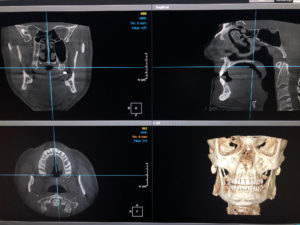
A healthy smile builds self-confidence and a positive mindset.
WE TAKE EMERGENCIES AND WALK-INS
What are the signs and symptoms of TMJ temporomandibular joint disorders?
The most common symptom of TMJ temporomandibular joint disorders is pain or tenderness in the jaw area, especially when opening or closing the mouth, chewing, or yawning. The pain may be felt on one or both sides of the face and radiate to other areas, such as the ear, temple, neck, or shoulder.
– Other signs and symptoms of TMJ disorder may include:
-Difficulty opening or closing the mouth fully
-Clicking, popping, or grating sounds when moving the jaw.
-Locking of the jaw in an open or closed position
-Headaches, earaches, or ringing in the ears (tinnitus)
-Facial swelling or numbness
-Changes in hearing or vision
How are TMJ disorders diagnosed?
You should see your doctor or dentist for a proper diagnosis if you have any of these symptoms. They will ask you about your medical history, examine your jaw and teeth, and perform some tests to rule out other conditions that may cause similar symptoms.
Some tests that may be used to diagnose TMJ disorders include:
-Dental X-rays to check for tooth decay, infection, or abnormalities in the jaw bone.
-CT scan (computed tomography) to provide detailed images of the bones and tissues involved in the joint.
-MRI (magnetic resonance imaging) reveals problems with the disc (a cushion-like structure) that separates and stabilizes the bones in the joint.
-TMJ arthroscopy (a minimally invasive procedure that involves inserting a small camera into
the joint space) to view the inside of the joint.
How are TMJ temporomandibular joint disorders treated?
The treatment for TMJ disorders depends on several factors, such as the severity of the symptoms.
TMJ disorders can be managed with conservative measures that do not require surgery.
Some examples of nonsurgical treatments for TMJ disorders include:
-Medications such as pain relievers, anti-inflammatories, muscle relaxants, or antidepressants to reduce pain, inflammation, spasms, or stress
-Oral splints or mouth guards (occlusal appliances) to prevent teeth grinding, correct bite alignment, or protect the teeth and jaw from injury
-Physical therapy to stretch and strengthen the jaw muscles, improve posture, and apply heat, ice, or ultrasound therapy
-Counseling to educate you about the factors and behaviors that may aggravate your pain, such as clenching your teeth, leaning on your chin, or biting fingernails, and help you cope with stress. In some cases, nonsurgical treatments may not relieve your symptoms, or you may have a more severe condition requiring surgery.
Some examples of surgical procedures for TMJ disorders include:
-Arthrocentesis (a procedure that involves flushing out debris and inflammatory substances from
the joint space with a needle)
-Arthroplasty (a procedure that consists in repairing, replacing, or removing damaged parts of the joint)
-Joint replacement (a procedure that involves replacing the entire joint with an artificial one)
-Surgery is usually considered a last resort.
Learn more about our Bothell dental services. You can also follow us on Facebook, Twitter, and Instagram.



